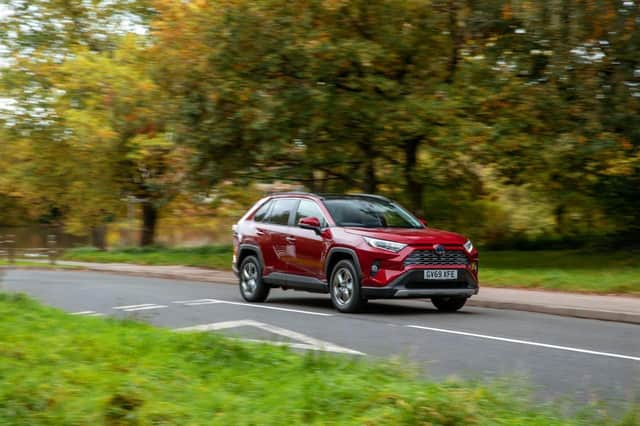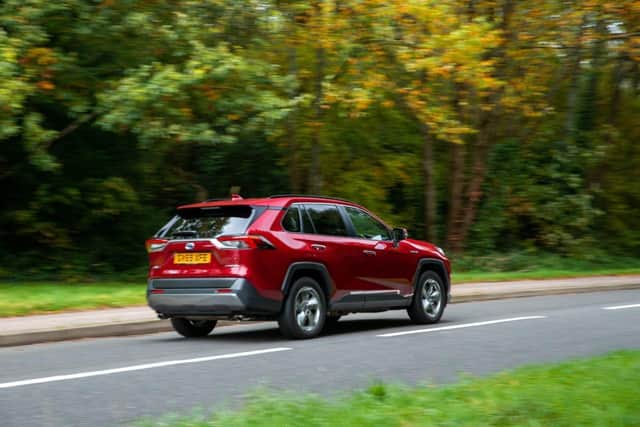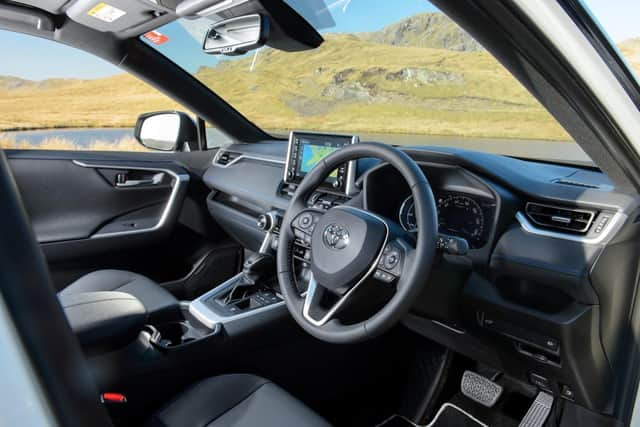How RAV4 transformed into a premium model


Range Rover began as a slightly upmarket 4x4 before Land Rover decided – again, bravely – that it should be the ultimate prestige vehicle. Later the Defender took a similar shift upmarket.
Into the fray, we also have the RAV4 tested here. It began as a relatively compact little off-roader, akin to a Suzuki Vitara. Now it has shifted a long way upmarket and Toyota must be delighted with its success.
Advertisement
Hide AdAdvertisement
Hide AdEarly RAV4s included cute three-door models but now only the five-door version survives, and it has grown in size and quality. It is now one of the most respected 4x4s in the market.


I have to say I’m impressed. This is a near £40,000 model but it stands comparisons with vehicles cost £50,000-plus.
So, what is the RAV4? It is a fifth generation model which stands for recreational active vehicle and it dates back to 1994.
Some claim it to be the first compact crossover. The latest version is built on a new chassis which, Toyota say, brings benefits in ride, handling, safety and driver enjoyment.
Advertisement
Hide AdAdvertisement
Hide AdIt is if anything under-styled. That is to say, it is a modest car which whispers its qualities, Having said that, it does have a more aggressively sculpted front than previous models.


It comes with a splendid engine and motor combination which is fuss-free. It is petrol-powered so range anxiety, the bane of electric vehicles, doesn’t apply. Having said that it claims more than 40mpg. I found it did 39mpg during my week at the wheel on various roads.
The new chassis means this vehicle has a low ride height. Low at least for an SUV, so it feels more car like. It is quiet, refined and has a sporty nature. For an SUV, it feels firm.
The vehicle has plenty of space for five with especially good accommodation in the back seats. The rear seats fold easily and the shelf is easy to remove when not required, leaving a van-like loadbay.
Advertisement
Hide AdAdvertisement
Hide AdRAV4 claims to unique in its class in offering customers a self-charging, hybrid powertrain – the choice of an overwhelming majority of customers for the model across Europe.
The new 2.5-litre petrol hybrid engine, offering 215bhp in front-wheel drive form and 219bhp with all-wheel drive, strengthens customer appeal, delivering step-changes in power, responsiveness and efficiency, with best-in-class fuel economy and emissions levels.
At the same time, the all-wheel drive system has been improved to achieve a “drive on any road” capability. It feels sporty and reaches 60mph in just over eight seconds.
The all-wheel-drive (AWD-i) system has been re-engineered to provide much stronger performance in challenging conditions and secure handling on slippery surfaces. This was also the first Toyota model to benefit from additional Toyota Safety Sense features.
Advertisement
Hide AdAdvertisement
Hide AdAnother key benefit of the new body is that all-round visibility has improved. The bonnet sits lower, adding to the driver’s forward field of vision. The external mirrors have been moved to a lower position on the front doors, the front pillars have been made slimmer, the belt line has been lowered and the rearward view from the driver’s seat has been improved by enlarging the rear side windows.
The load space behind the rear seats has been made larger and more user-friendly, notably thanks to a fully flat floor and a length extended by 60mm to secure best-in-class capacity, 79 litres more than in the previous, fourth generation RAV4. Toyota say the loadbay is so tall it can hold a 29in mountain bike without removing the wheels. The rear seats have a 60-40 split-folding function and there are storage nets on each side of the boot. Clever details include a hand grip on the tailgate that can serve as a hanger and a power-operated tailgate with hands-free function.
Tested here is the Excel model which is the flagship. It has a panoramic sunroof, smartphone integration, heated seats, five USB points and no end of safety features.
Safety Sense, as Toyota calls the package, includes systems to trigger automatic braking or steering assistance.
Advertisement
Hide AdAdvertisement
Hide AdThe improved system also features a single-lens camera and millimetre-wave radar. The unit has also been made smaller, so the driver gains an even wider field of vision. The package includes upgraded versions of the Pre-Collision System with Pedestrian Detection, intelligent Adaptive Cruise Control, Lane Departure Alert with Steering Assist, Road Sign Assist and Automatic High Beam.
It also introduces Lane Tracing Assist, which provides more advanced driving support. The Pre-Collision System has been extended so that as well as vehicles it can now detect pedestrians on the road ahead during low-light driving as well as in daylight. It also has the added capability of recognising bicycles in the vehicle’s path, at relative speeds of between approximately 6mph and 50mph, during daylight hours.
Where vehicles are concerned, the system can determine collision risks at speeds from zero to 112mph. If it calculates an imminent risk of collision, it will alert the driver and prepare the brakes (Pre-Collision Brake Assist) for maximum stopping force. If the driver fails to act, it will trigger Autonomous Emergency Braking.
Being an Excel, it also has powered driver’s seat and full leather upholstery. There are flashier-looking SUVs around but few which have so much kit for the money.
Toyota RAV4 Excel 2.5 Hybrid
Advertisement
Hide AdAdvertisement
Hide AdPrice: £37,755. Options on test include Premium Pack (£1,645) and Essential Protection Pack (£259)
Engine: 2,487cc four cylinder petrol engine with transmission via electric CVT (continuously variable transmission)
Costs: Official average 47.9mpg. On test, it averaged 39mpg
Performance: Top speed 112mph and 0 to 60mph in 8.1 seconds
Insurance: Group 30A
Emissions: 133g/km
Warranty: Three years’ manufacturer warranty can be extended with regular servicing at a Toyota dealer.